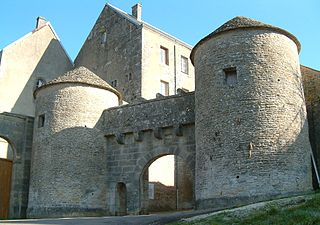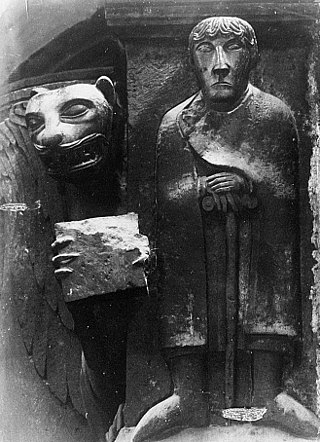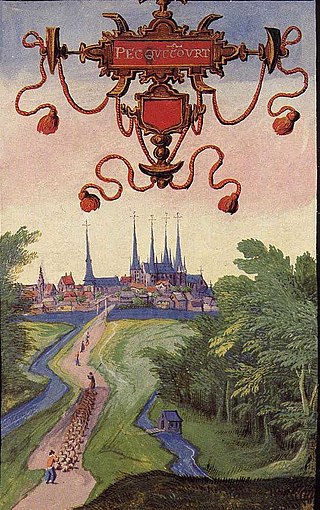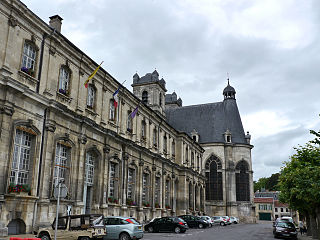
Mont-Saint-Michel is a tidal island and mainland commune in Normandy, France.

Flavigny-sur-Ozerain is a commune in the French department of Côte-d'Or, in Bourgogne-Franche-Comté.

The Antiphonary tonary missal of St. Benigne was written in the last years of the 10th century, when the Abbot William of Volpiano at St. Benignus of Dijon reformed the liturgy of several monasteries in Burgundy. The chant manuscript records mainly Western plainchant of the Roman-Frankish proper Mass and part of the chant sung during the matins, but unlike the common form of the Gradual and of the Antiphonary, William organized his manuscript according to the chant genre, and these sections were subdivided into eight parts according to the octoechos. This disposition followed the order of a tonary, but William of Volpiano wrote not only the incipits of the classified chant, he wrote the complete chant text with the music in central French neumes which were still written in campo aperto, and added a second alphabetic notation of his own invention for the melodic structure of the codified chant.

Saint Aubert, also known as Saint Autbert, was bishop of Avranches in the 8th century and is credited with founding Mont Saint-Michel.

The arrondissement of Avranches is an arrondissement of France in the Manche department in the Normandy region. It has 134 communes. Its population is 134,724 (2016), and its area is 1,888.2 km2 (729.0 sq mi).

Robert of Torigni or Torigny, also known as Robert of the Mont, was a Norman monk, prior, and abbot. He is most remembered for his chronicles detailing English history of his era.

Saint William of Volpiano was a Northern Italian monastic reformer, composer, and founding abbot of numerous abbeys in Burgundy, Italy and Normandy.

Bertram de Verdun was the name of several members of the Norman family of de Verdun, native to the Avranchin.

Ouche Abbey or the Abbey of Saint-Evroul is a former Benedictine abbey in Normandy, located in the present commune of Saint-Évroult-Notre-Dame-du-Bois, Orne, Normandy. It has been classified as a Monument historique since 1967 and is designated "classé".

Les Préaux is a commune in the Eure department and Normandy region of France.

Anchin Abbey was a Benedictine monastery founded in 1079 in the commune of Pecquencourt in what is now the Nord department of France.
Ranulf de Briquessart was an 11th-century Norman magnate and viscount.

Maurice II de Craon was Lord of Craon, Governor of Anjou and Maine under Henry II, a military figure and Anglo-Norman of the 12th century. Maurice II also possessed fiefs in England which he held courtesy of Henry II.

The Mont-Saint-Michel Abbey is an abbey located within the city and island of Mont-Saint-Michel in Normandy, in the department of Manche.

Saint-Mihiel Abbey is an ancient Benedictine abbey situated in the town of Saint-Mihiel, near Verdun in the Meuse department in Lorraine in north-eastern France.
William fitzWimund was a Norman landholder in England after the Norman Conquest.

The Prieuré de l'Oiselière is a priory located at Saint-Planchers, near Granville, in France. Nestled in a valley bordering the watercourse that bears its name, surrounded by fortified walls and moats, its history dates back to the 12th century. It was a dependency of the abbots of Mont-Saint-Michel who organised the cultivation of the fields and the woods and collected taxes. It was also a local justice court.
Norgod was bishop of Avranches from 990 to 1017-c.1022. Almost nothing is known about him, and his first appearance as bishop dates from the foundation of Fécamp, on 15 June 990. After that, he appears c. 1015 witnessing two charters with donations to Mont Saint-Michel, by Robert, Count of Mortain, and Gunnor, wife or Richard I. Finally, in 1017, he witnessed a charter by William of Volpiano concerning the privileges of the monks of Fruttuaria. He removed himself to Mont Saint-Michel soon after, where he finished his days as a monk. He died either on 14 October, either on 1026 or 1036.

The Fontevraud Gradual is an antiphonary or gradual of the mid-13th century, owned by Eleanor of Brittany, abbess of Fontevraud Abbey, and bequeathed to the abbey on her death. It contains Gregorian chant as well as three early polyphonic pieces. It is also noted for its miniatures in the form of historiated initials.
















